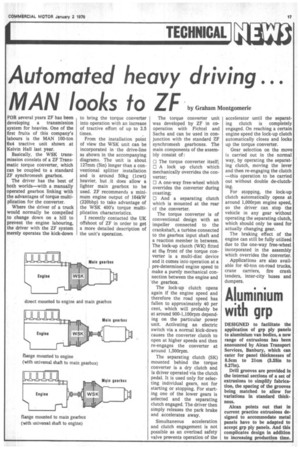Automated heavy driving ...
Page 19

If you've noticed an error in this article please click here to report it so we can fix it.
MAN looks to ZF by Graham Montgomerie FOR several years ZF has been developing a transmission system for heavies. One of the first fruits of this company's labours is the MAN 100-ton 6x4 tractive unit shown at Kelvin Hall last year.
Basically, the WSK transmission consists of a ZF Transmatic torque converter, which can be coupled to a standard ZF synchromesh gearbox.
The driver has the best of both worlds—with a manually operated gearbox linking with the advantages of torque multiplication for the converter.
Where the driver of a truck would normally be compelled to change down on a hill to prevent the engine labouring, the driver with the ZF system merely operates the kick-down to bring the torque converter into operation with an increase of tractive effort of up to 2.5 times.
From the installation point of view the WSK unit can be incorporated in the drive-line as shown in the accompanying diagrams. The unit is about 127mm (5in) longer than a conventional splitter installation and is around 50kg (lcwt) heavier, but it does allow a lighter main gearbox to be used. ZF recommends a minimum engine output of 164kW (220bhp) to take advantage of the WSK 400's torque multiplication characteristics.
I recently contacted the UK offshoot of ZF in order to get a more detailed description of the unit's operation. The torque converter unit was developed by ZF in cooperation with Fichtel and Sachs and can be used in conjunction with the standard ZF synchromesh gearboxes. The main components of the assembly consist of : E The torque converter itself; O A lock up clutch which mechanically overrides the converter; 11] A one-way free-wheel which overrides the converter during coasting; O And a separating clutch which is mounted at the rear cf the converter.
The torque converter is of conventional design with an impeller connected to the crankshaft, a turbine connected to the gearbox input shaft and a reaction member in between. The lock-up clutch (WK) fitted at the front of the torque converter is a multi-disc device and it comes into operation at a pre-determined engine speed to make a purely mechanical connection between the engine and the gearbox.
The lock-up clutch opens again if the engine speed and therefore the road speed has fallen to approximately 40 per cent, which will probably be at around 900-1,100rpm depending on the particular power unit. Activating an electric switch via a normal kick-down causes the converter clutch to open at higher speeds and then re-engages the converter at around 1,500rpm.
The separating clutch (SK) mounted behind the torque converter is a dry clutch and is driver operated via the clutch pedal. It is used only for selecting individual gears, not for starting or stopping. For starting one of the lower gears is selected and the separating clutch engaged. The driver then simply releases the park brake and accelerates away.
Simultaneous acceleration and clutch engagement is not possible as an overload safety valve prevents operation of the accelerator until the separating clutch is completely engaged. On reaching a certain engine speed the lock-up clutch automatically closes and locks up the torque converter.
Gear selection on the move is carried out in the normal way, by operating the separating clutch, moving the lever and then re-engaging the clutch —this operation to be carried out without double de-clutching.
For stopping, the lock-up clutch automatically opens at around 1,000rpm engine speed, so the driver can stop the vehicle in any gear without operating the separating clutch, which should only be used for actually changing gear.
The braking effect of the engine can still be fully utilised due to the one-way free-wheel incorporated in the assembly which overrides the converter.
Applications are also available for 40-ton on-road trucks, crane carriers, fire crash tenders, inter-city buses and dumpers.




































































